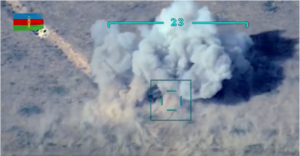UKRAINE’S DRONE STRIKE IN DONBASS CAN SPARK A TURKISH – RUSSIAN ESCALATION
Dr. Can Kasapoglu
Director, Security & Defense Program, EDAM
- On October 26th, 2021, the Ukrainian Armed Forces used Turkey-transferred Bayraktar TB-2 unmanned aerial systems to destroy an artillery position of the Russia-backed rebels in Donbass.
- The blast radius suggests the use of the Roketsan-made MAM-C smart drone munitions, the lighter combat configuration for Turkish unmanned aerial solutions, including the Bayraktar TB-2. As a comparative reference, during the Karabakh War, the Azerbaijani military’s principle strike force relied on the heavier MAM-L variant. It remains to be seen if Turkey already transferred, or will transfer, the MAM-L to Ukraine which would bring an additional edge over the pro-Russian rebels’ armored platforms.
- Weighing only 6,5 kilograms, the MAM-C is suitable against lightly armored and unarmored target-set. In fact, the Ukrainian Armed Forces were previously filmed flying Bayraktar TB-2s with MAM-C munitions.
- The visual evidence suggests that the target was, likely, a 122mm D-30 towed howitzer, a Soviet-era fire-support weapon used by many belligerents around the world, including the Russia-backed separatists in eastern Ukraine.

Footage showing the blast radius from the Ukrainian military’s drone strike, probably a MAM-C round.

Bayraktar TB-2, MAM-L strike’s blast radius, Karabakh War.
- The Ukrainian military has previously resorted to the Bayraktar TB-2 drones in its anti-terrorism operations against Russia-backed separatists, albeit, predominantly in ISTAR (intelligence, surveillance, target acquisiton, reconnaissance) missions. However, this time, Kyiv opted for a direct kinetic strike which marked a new phase for the role of Turkey-supplied weaponry in the ongoing bonanza between Ukraine and Russia.
- Resembling the Arab – Israeli wars of the Cold War era, which offered a comparative test field for the Western and Soviet arms, the conflicts in Syria, Libya, and especially Karabakh have offered a similar tour d’horizon, considering the Turkish drone warfare systems’ effectiveness against Russian weaponry. A careful assessment of the combat record reveals certain vulnerabilities of the Russian military hardware, especially in the absence of adequate networked sensor capabilities and situational awareness.
- With Turkey becoming a drone exporter at Russia’s doorstep, and ironically, the only NATO Ally that procured the S-400 strategic SAM system, Moscow faces difficult tradeoffs.
- Should the Ukrainian military wages a systematic drone warfare campaign on the pro-Russian militia or boosts the operational tempo, the Kremlin can respond to Ankara, chief UAS supplier of Kyiv.
- One particular area that Russia can bleed Turkey is Idlib, Northwestern Syria. Notably, back in early February 2020, a joint air-strike by the Russian Aero-Space Forces and the Syrian Arab Air Force claimed the lives of 36 forward-deployed Turkish troops in the Idlib frontier. For some time, the Russian air-strikes have been pounding the area where Turkey has fielded several expeditionary formations. The Syrian Arab Army also enjoys a heavy buildup near Idlib with Russia-supported General Suheil Hassan and his 25th Division operating in the frontlines.
- The Donbass incident can also trigger a surge in Russia’s counter-drone and electronic warfare support to the Ukrainian separatists. In light of the lessons-learned from Syria, the Russian defense industrial & technological base have long invested in hard-kill and soft-kill drone counter-measures, such as the new, drone-specific interceptors for the Tor-M2 air defense system and Sapsan Konvoy electronic counter-drone system.
- Russia has been already intensively using electronic warfare (EW) assets in Ukraine across a broad spectrum of tasks, ranging from protecting artillery units to targeting and harvesting signals intelligence about the Ukrainian formations, to psychological operations by sending discouraging messages to the cellphones of the Ukrainian military personnel. Notable Russian EW systems, such as the RB-341V Leer-3, were already spotted in eastern Ukraine. From now on, one can expect an even more towering Russian EW posture in support of the Moscow-backed rebels.
- Ankara and Kyiv enjoy a burgeoning defense cooperation with co-production and technology transfer opportunities. Besides, Turkey has already agreed to provide Poland with Bayraktar TB-2s, and Turkish robotic warfare solutions manufacturers are eyeing the Baltic weapons market. In a broad geopolitical axis ranging from Syria and Libya to Karabakh, Turkish and Russian interests remain at odds. Overall, while the S-400 procurement has portrayed an uptrend in the Turkish – Russian bilateral ties, the two nations have deep strategic divergences and rivalries.




